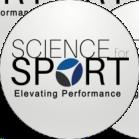

Study Details



Study Details
Prac�cal Takeaways from study
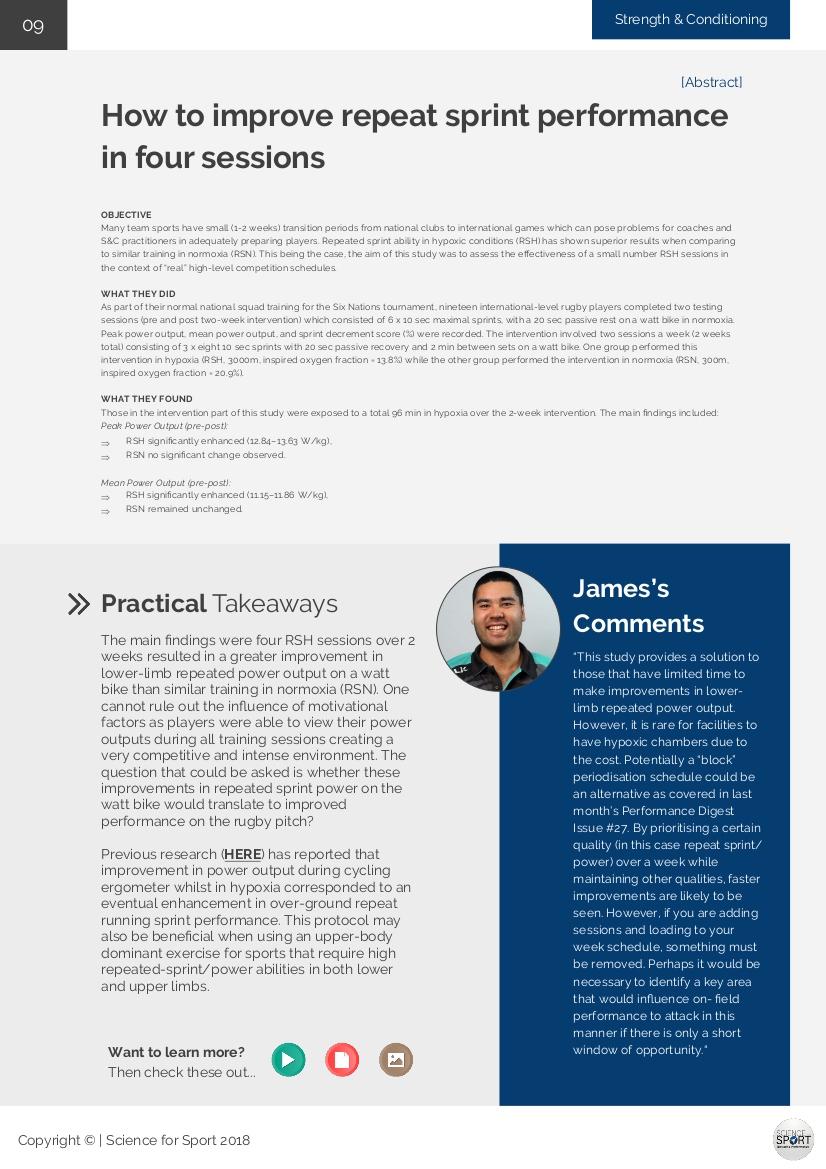
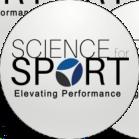
Related links to learn more about the topic
Reviewers comments on the study
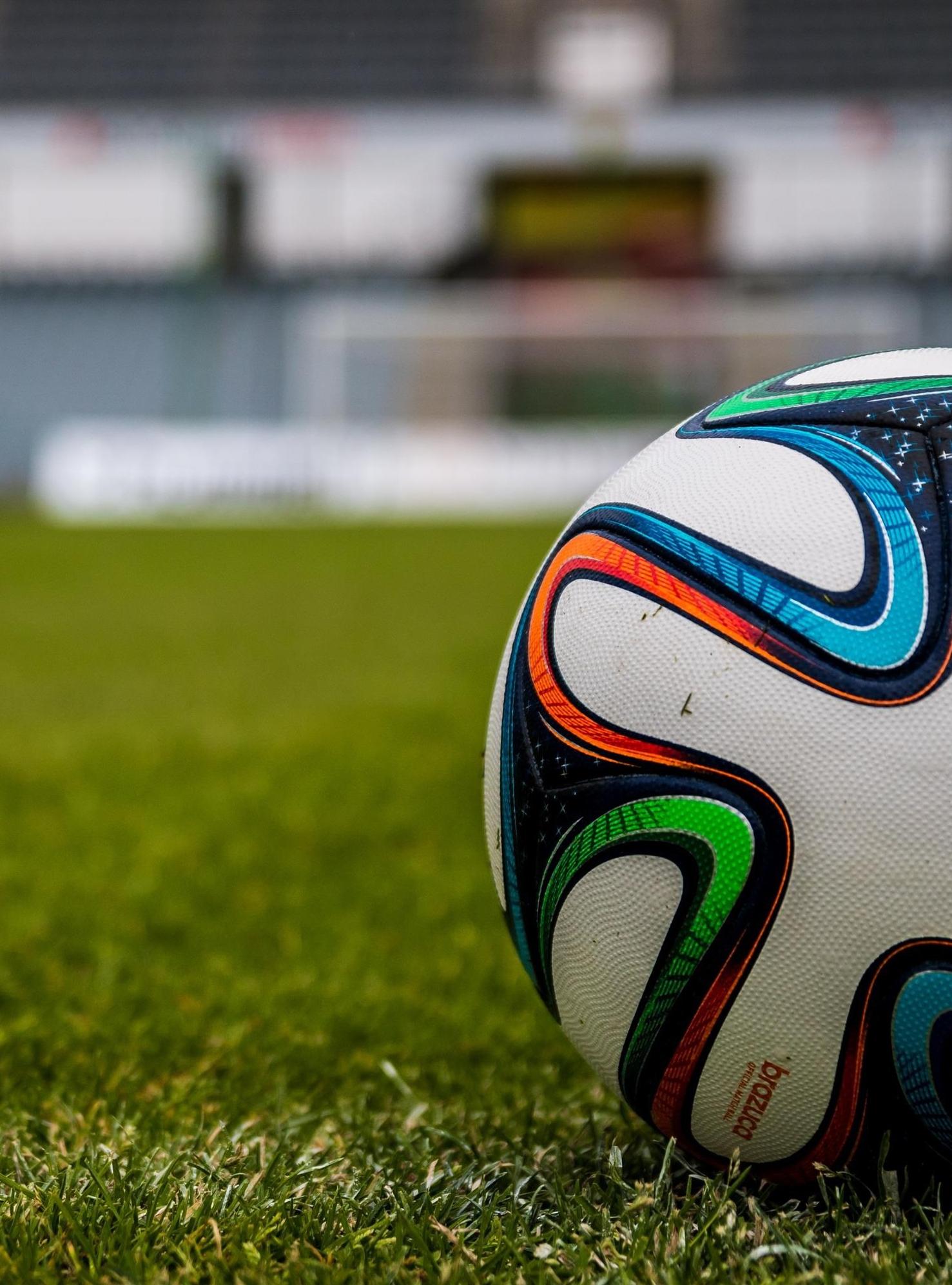


James is currently the Head Strength & Conditioning Coach for the Romanian Rugby Union He has previously worked in America s professional rugby competition Major League Rugby with Austin Elite and the NZ Women ’ s National Rugby League Team He is a published author and has completed a MSc in Sport & Exercise Science from AUT Auckland NZ.


Cody is a strength and conditioning coach and adjunct lecturer at the University of Iowa. He has an MSE in Exercise Science from the University of Kansas and also holds a CSCS from the NSCA
Dr. Jordan August DPT, CSFC, SFMA, FMS
Injury Prevention & Rehab
Jordan is a Physical Therapist and Strength Coach who currently practices in a Sports & Orthopedic clinic in Bergen County, New Jersey He is passionate about educating athletes on ways to optimize performance while decreasing the risk of injury


Tom is the Head of Athletic Development at St Peters RC High School. He holds a Masters in S&C and has previously worked with West Bromwich Albion FC, Gloucester Rugby club, and Great Britain Equine Tom is our youth research reviewer at Science for Sport


James is a Performance Nutritionist for the English Football Association and works alongside the England national teams (men's and women s). He is also a SENr registered performance nutritionist and holds a PhD from Liverpool John Moores University
Fatigue & Recovery
Matthew is a Physical Therapist and the Clinical Director at a private Physical Therapy clinic in NYC. He has a special interest in the treatment of lower extremity/foot and ankle injuries along with helping runners and walkers to get back to what they love to do.

OBJECTIVE
Talent identification and development is a highly complex and competitive process in many elite sports.
Progression through a talent identification pathway relies on a number of factors, such as performance data, technical and tactical knowledge, and suitability to the organisation's culture. Therefore, coaches and sport scientists can play a large role in an athlete s progression.
As competition increases, selection becomes an increasingly challenging process, where the smallest differences between athletes can be the defining factor in a successful transition into the senior team. Despite the plethora of research surrounding talent identification, few studies, if any, have investigated if successful players make consistent improvements in their performance, or start and remain on top of the talent pool.
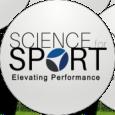
Therefore, this study aims to explore the longitudinal relationship between talent variables and their relationship with development over time.
One-hundred and ten youth football players (8-12yrs) participated in this study from a Dutch academy. Inclusion criteria required players to be in good physical condition and to be clear of injury/sickness throughout the study

All athletes had the same programme, with no players being dropped during this longitudinal study lasting fiveyears. To monitor predictors of selection, anthropometry, physical fitness (10, 20 and 30m sprint, a modified arrowhead agility test, standing long jump), gross motor skills test (KörperkoordinationsTest für kinder and Athletic Skills parkour test), technical ability (Loughborough passing test) and psychosocial capacities (Scale for Identification of Sport Potential) were tracked over fiveyears.
Players were tested monthly and independent samples ttests were used to assess differences in variables of those who were selected into the U13 team for every participant.

From this study, coaches should look to chase physical development by providing regular and consistent strength and conditioning sessions. Given that ‘physicality’ and 20-30m speed are highlighted as desirable traits, S&C coaches can play a key role in developing these qualities. Considering children are not producing high levels of androgens between 8-12yrs, a majority of the adaptations to strength training will be neural in nature. Training approaches that will support this can be achieved by incorporating:
1. Heavy sled drags are a fantastic way to drive force adaptations whilst developing good sprint mechanics. Cumulatively, the results from a recent study (HERE) show the greatest gains in short-distance sprint speed were made when youth trained at loads greater than 50% of bodyweight over 6-9 repetitions. Before working at this load, I would recommend a far lighter load (10% of bodyweight) to develop a good technical base. In the attached video, sled drags are preferred to sled pushes as the arms are free to move with the contralateral leg. This is more ecologically valid to the key positions of sprinting (e.g. big arm split, horizontal lean and positive shin angles).
2. High levels of eccentric strength training – initial approaches to incorporating eccentric training can be achieved by
Want to learn more?
Then check these out...

performing exercises such as Romanian Deadlifts (HERE), hamstring sliders (HERE) and Nordic Hamstring exercises (HERE). These can be advantageous when looking to develop landing kinematics, eccentric strength, braking strength, and deceleration/change of direction ability
When incorporating eccentrics, the attached article recommends 1-2 sets of 6-8 repetitions for beginners, moving to 2-3 sets of 6-8 reps over 8-weeks. In addition to the strength improvements, eccentric exercises are highly effective as injury preventatives and muscle myofibrillar hypertrophy
3. Improve ankle stiffness – ankle stiffness has a long association with sprint speed. In an athletic sense, stiffness describes the ability of the body or ankle to resist deformation. A stiffer leg-sprint should augment performance by utilising elastic energy. Stiff ankles show a high correlation with sprint speed and optimal stride length (HERE). To develop stiffness, plyometric tasks with short ground contact times are preferable. These may include ankling, skipping, pogo jumps and various hops. Asking youth to ‘follow a leader’ or create a trail is a fantastic way to keep S&C playful whilst working on ankle stiffness mechanics.
The main finding of this study was that there were few differences in the developmental trajectories between selected and non-selected players between the ages 812. Although both selected and non-selected players improved, there was no sudden leap in performance variables through these age groups. However, greater identifiable features were found when using crosssectional analysis. These results indicated that among the players who progressed to the U13 team, the selected players were already superior in a number of talent indicators and maintained this advantage throughout the 8-12 phases of the programme. These included increased strength, speed, and conditioning. These identifiable factors were identifiable from the age of 9. The differences in gross motor coordination, footballing ability and psychosocial characteristics were far less obvious. Out of all of the variables measured, sprint speed over 20-30m showed the highest correlation with selection, where faster players were more likely to be selected.

“"The results from this study indicate that although both selected and non-selected players benefit and improve as a result of training, a natural “gap” does exist and continues to exist after years of training. Therefore, it is important that those who are less developed physically take steps to catch up to their more physical peers in order to influence the selection process. As well as seeking S&C support for physical qualities, my experience of talent identification has seen that individuals who do the basics well (e.g. punctuality, organised, friendly etc.) are also likely to succeed despite physical disadvantages.
"In the attached podcast, Jim Miller (Chief of Sports Performance at USA Cycling) suggests individuals who are motivated, employ a growth-mindset, build relationships, set goals and prioritise their development as athletes are more likely to perform at the highest level. My philosophy about working with youth completely aligns with this, as realistically not all will make it to the highest level. Therefore, the biggest credit our athletes can give to us when they leave is that they are good people, with strong values and identities. This places them in good stead to secure future opportunities in sport and employment, falling under the responsibilities of a holistic long-term athletic development (LTAD) programme.

"Finally, sprint speed over 20-30m proved to be a factor that selection identified as significant. Therefore, coaches should look to continually develop sprint speed over acute distances (<50m), to ensure players stand a fighting chance of being advanced through the LTAD system. Those activities mentioned in the practical takeaways, coupled with some tempo runs (e.g. 50m in 6 seconds) should develop anaerobic qualities to drive sprint performance. Tempo runs should only occur when maximal sprinting technique (HERE) can be maintained.”

Periodising and planning training load (TL) is a great start and important step in the process of setting up a team to be prepared for a competitive season. However, the management and monitoring of said plan is arguably more important, as what looks great on paper does not always play out as expected. As Mike Tyson said, “everyone has a plan, until they get punched in the face.”
When the appropriate variables are collected and managed properly (e.g. modulating training to increase readiness), coaches and athletes succeed. This is done through a combination of measuring both internal and external variables, as well as leaning on both subjective reports (e.g. rating of perceived exertion (RPE) or total quality of recovery (TQR) and objective measures (e.g. total distance (TD) or time spent above a certain speed).
Monitoring multiple TL variables is a constant pursuit that provides coaches with actionable feedback towards each athlete s response to workload, and it is important to recognise the context, interaction, and specificity of this insight. Therefore, researchers assessed multiple subjective and objective TL measures (e.g. TQR, RPE, heart rate (HR), TD, speed) for a NCAA Division-I men s soccer, assessing variations based on position across a season.
A team of 21 male soccer players (age 19.4±1.4-yr) were assessed over a 14-wk period during their NCAA Division-I season. Players were separated by position (centre forward, centre midfielder, wide midfielder, centre back, and wide back), excluding goalkeepers.
Only full-team (starters and reserves) practices were monitored using heart rate and global positioning system (GPS) technology
The 14-wk testing period included pre-season (6-wk) and inseason (8-wk) blocks. The pre-season was divided into two 3wk phases (Pre1 and Pre2), and the in-season block into four 2wk phases (In1, In2, In3, In4) in order to provide context on competitions during each phase and relative comparison. Players reported a TQR score upon arrival to training, and an RPE in the 15-30-min post-practice, as subjective-internal measures. RPE was later multiplied by the session duration to provide an ‘RPE Load’ metric. Time spent >85% predicted HRmax, time between 65-85% HRmax, and time <65% HRmax were analysed (%Hrhigh, %HRmid, %HRlow, respectively) to represent an objective-internal load measure. Lastly, running speed was measured as time spent(min) >7.2km*h-1 (SZupper) and �7.2km*h-1 (SZlower), as well as total distance covered(m) as the objective-external GPS metrics.
The various metrics were analysed for comparison between playing position, as well as phase of the season.
It is critical coaches respect and understand the demands that each position will experience during the competitive season. With this understanding, coaches can appropriately and adequately develop and prepare players during the off- and pre-season periods. Coaches should gradually bring up training loads to the necessary volume, intensity, and frequency that will be experienced in-season, so these known workloads are not as stressful or damaging as they would otherwise be.
Position-specific demands are also specific to the team and a coach’s given style of play. Research gives us a general idea (see ), but collecting HERE data GPS across a season or two provides specific and relative understanding for a playing position’s workload in a match (e.g. backs being required to be more active, experiencing higher intensity efforts, or centre midfielders operating steadily at %HR-low to -mid in a defensive and reactive role).
When collecting HR values, coaches should not look at data with the goal that a higher HR is better Heart rate is a relative measure of intensity, but at the same time a more favourable heart rate response (lower value) to a given effort would signify a more efficient cardiovascular system and a more robust (‘fit’) athlete. Coaches can monitor and assess improvements (increased fitness) like this by comparing an early pre-season session to a similar (volume and intensity) early in-season session, with the hopes of %HR being lower
Data metrics should rarely be used in isolation, but rather, coaches should be pairing measured variables to find relationships. For example, when
comparing RPE with HR, TD, or time in Szupper, if subjective RPE Load is elevated, we would hope we could identify another objective measure that has also increased in accordance. If not, then coaches should either watch that athlete closely in the coming days (e.g. checking for an improved TQR score before the next training session) or inquire directly about how things are going outside of playing (e.g. stress, sleep, nutrition) without being overly intrusive.
Collecting individualised, subjective measures (RPE) after training is vital insight that allows coaches to better understand TL. Research has shown that coaches are poor predictors of identifying an athlete’s perception of effort (see ). Coaches should take time to collect this HERE information unbiased and use it with a supportive mindset.
Coaches need to respect that RPE is a measure of TL, reflecting an athlete’s internal intensity, and is not necessarily a mark of readiness (performance potential). Simply, a high or low RPE is not predictive of a good or bad performance (see ), but coaches should HERE appreciate that more recovery (time) may be necessary following higher reports of intensity
Alternatively, TQR quantifies an athlete’s perceived level of readiness, which represents a psychophysiological state that must be appreciated, especially when planning to expose athletes to high-intensity efforts (sprinting and change of direction at full speed). If reports of recovery are low (poor) at the start of practice, coaches may consider modifying training (reducing intensity or volume). This can help build trust between the coach and athlete, not to bail them out of complaining but to optimally prepare them for competition. If TQR reports are habitually low and training is constantly being modified, then there needs to be follow up and problem solving between coach and athlete.
Internal and external TL differed between positions. Specifically:



§ Wide backs spent 4-10-min more in the SZupper zone, and more time at %HRhigh during the preseason period compared to other positions.
§ Furthermore, wide backs had lower TQR scores than centre- and wide-midfielders during the Pre2 phase.
§ Across the In1 phase, centre backs had lower TQR scores compared to midfielders, which was consistent with less time spent in SZlower and more time spent in %HRhigh relative to other positions.
However, TD covered between positions was similar across the season, even reducing ~33% between In2 and In3 for all positions.
Only during the In3 phase was there a discrepancy in RPE load between positions, with centre backs being greater, and recording less time in %HRlow zone during that phase of the season, as well.
“The purpose of monitoring is to provide specific feedback relative to the efforts and workloads of an athlete and team. With this insight, coaches can provide training that sufficiently prepares them for competitive demands, prescribing and modifying loads based on recovery needs and readiness level. The most effective way to go about this involves collecting multiple measures to provide context and understanding. Therefore, when aiming to understand an athlete s psychophysiological state, it is important to collect both subjective (athlete perception) measures, which leans heavily to the psychological component, as well as objective measures, which are direct measurements of an athlete’s physiological output. Likewise, these metrics should provide an accurate representation of the intensity of workload. For example, the upper and lower speed zones identified in this research were arguably limited in identifying high-intensity running, seeing that it was polarised to separate out walking and jogging paces (<7.2-km/h) and anything above being acknowledged as ‘upper speed zones. Therefore, critical consideration should be given to identifying truly highintensity demands (>85%-maximum) for a better understanding of demands and performance.
“By pairing metrics, coaches can support their expectations (e.g. prescribing a high-intensity practice, receiving high RPE reports and noting ample time spent in %HRhigh) and gain understanding (e.g. identifying potential fatigue if RPE and HR is high with speeds and distances decreased). This lends itself to the concept of being ‘data informed’ versus ‘data driven,’ where monitoring data can help to feed expectations and guide training decisions.”


“But it is critical to appreciate the complexity of recovery, performance and all the athlete is balancing.”

This month’s top research in strength & conditioning.
HOW DOES MECHANICAL LOADING AFFECT THE KNEE?
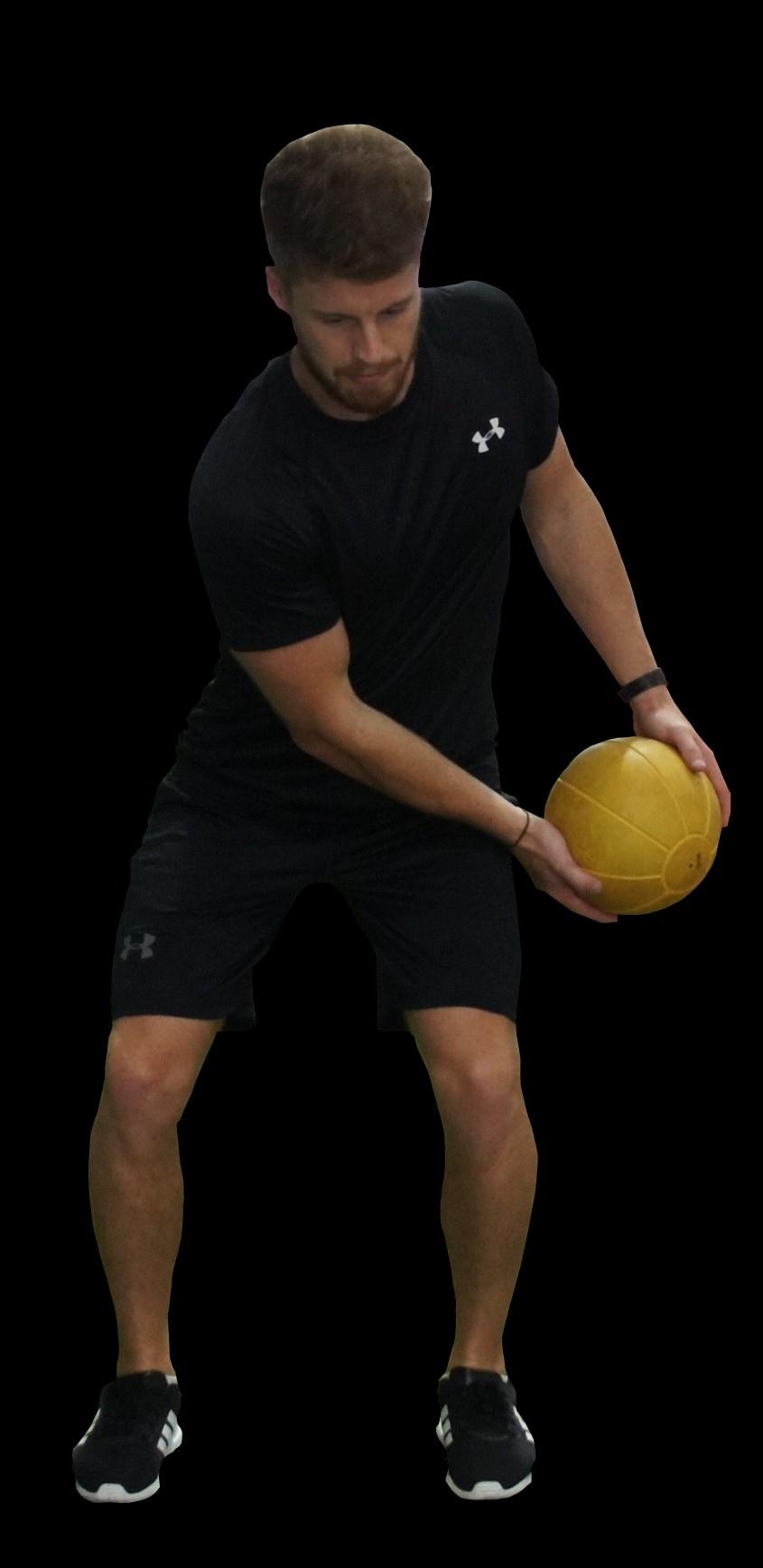
HOW IMPORTANT IS THE LOWER BODY TO PUNCHING IMPACT FORCE
HOW SHOULD YOUR ANKLE BE POSI DURING THE NORDIC HAMSTRING E
WHAT IS THE IMPACT OF STRENGTH TRAINING ON INJURY RATES IN PROFESSIONAL BASKETBALL?





Mechanical loads are encountered by the knee joint during daily activities along with sport-specific movements. They can be described as the physical forces that act on the joint to create demand on it through varied movements.
Within the knee joint itself, there are ligaments, tendons, menisci, cartilage and bone which all are affected by load and movement in different ways. It is imperative that rehabilitation professionals understand tissue response at different structures in the knee in order to progress athletes properly through their rehab following injury
Appropriate selection of exercises and functional activities are dependent not only on the stage of the recovery but also on the structure that was affected. Poor understanding of tissue response to mechanical loading can lead to improper healing and delayed return to sport.
The current study defined the different structures within the knee and how they are affected by physical forces. These include ligaments, tendons, menisci, cartilage and bone. With this, the specific rehabilitation guidelines for each area were established, allowing the rehabilitation professional to progress their athlete appropriately
How the knee functions is dependent on its load capacity, which is affected by the type along with the status of the tissue. Normal tissue has a greater ability to tolerate and adapt to load compared to a pathological or compromised tissue. If the structure has normal tissue properties, it is in a homeostasis or balanced state. In order to progress its tolerance, the stresses applied to it must be done in an appropriately gradual way. If applied stress is below that required for positive changes, the tissue can atrophy, causing weakness and potential delayed healing. If the tissue is stressed beyond its capacity it can lead to a greater risk of injury This applies throughout the knee regardless of structure.
Ligament response to load: Mostly made of type 1 collagen, ligaments have a cross-linked zig-zag pattern of fibres to allow them to undergo tension loads while lengthening. Ligaments can lengthen under tension and then return to their normal shape due to elastic properties. In order to achieve proper healing, ligaments should go through a gradual strengthening/loading program with addition of joint range of motion activity. If loading is excessive, remodelling of the ligament becomes stiff like scar tissue delaying healing.
Tendon response to load: Tendons transmit load from muscle to the bone and store and release that energy for movement. When loaded, tendons will deform or strain based on the magnitude of the force applied. This strain induces tendon adaptation which then causes it to reform to be able to increase its tolerance.
Meniscus response to load: Meniscus are fibrocartilaginous rings that sit on top of the lower leg bone and provide cushioning to the knee with mechanical loading. There is an inner zone which is less vascularised and an outer zone with improved vascularisation. When this ring is broken through excessive forces, it leads to abnormal contact forces through the knee leading to other structures being compromised.
Articular cartilage response to load: Cartilage in the knee requires appropriate weight bearing to improve load capacity. Mechanical forces through weight-bearing movements slows down cartilage volume decreases compared to non-weight bearing movements.

Bone response to load: Physical activity, including impact and weight-bearing activities, improves bone mineral density Non-weight bearing activities will not have the same effect.
The goal with rehabilitation of the knee is to maximise exercise capacity while minimising the risk of reinjury The balance between load and the capacity of the joint is significant. Load must be progressed gradually in a way that is slightly greater than current tissue capacity
Ligament rehabilitation: The ACL is the most discussed ligament in the knee. Range of motion, quadricep activation and early mobilisation are key in the beginning stages of rehabilitation. Athletes progress through weight-bearing exercises and full range of motion by the three month mark with a focus on appropriate quadricep to hamstring strengthening ratios. Following that, plyometric and return-to-sport activities are introduced and progressed appropriately
Tendon rehabilitation: Injured tendons have altered tissue structure, with associated pain. Early management should focus on reducing high intensity loads that provoke pain in the highly irritable tendon. As pain reduces, isometric exercises have been shown to immediately reduce pain. This is progressed through time under tension and volume. Following this, clinicians may use
eccentric strengthening and heavy slow resistance training in order to improve load capacity This must be monitored effectively through daily subjective pain responses.

Meniscus rehabilitation: Weight-bearing exercises should be performed as tolerated but athletes should avoid going below 90 degrees in the early stages of rehabilitation due to increasing compressive forces. Range of motion should be progressed based on the timing after injury/surgery and is dependent on the patient’s age and health status.
Cartilage and bone rehabilitation: Mechanical loading is appropriate, but repetitive and chronic overload can be detrimental. Graded resistive exercises are key to reduce pain, improve strength and slow cartilage volume declines.


"This paper describes how the knee joint is affected by mechanical loads and the appropriate measures to rehabilitate following injury There are a number of structures in the knee and all have varied tissue capacity when responding to external forces.
“The common aspect within the structures of the knee is the need for a gradual increase in stress from external forces. If the forces upon the knee are too excessive, it can lead to injury If the forces upon the knee are not enough to create tissue adaptation, the athlete will fall behind in their rehabilitation. It is imperative the rehabilitation professional understands how to improve load capacity in a gradual manner With this, rehabilitation can be staged appropriately minimising the risks of delayed healing for the athlete."

The goal in boxing is to win either by knockout or points. Both methods of victory require large impact forces when punching. While technique is crucial for enhancing punching impact force, improved physical capacities develop the engine underlying the punch.
Previous research has shown more experienced boxers have greater contribution from the legs when punching (see ). However, there is limited research HERE investigating the relationship between strength, power, and rate of force development (RFD) on punch impact force. Therefore, this study aimed to examine the relationship between strength, power, and RFD of the upper and lower body on punch performance.
Twenty-eight highly trained amateur male boxers (age = 19 ± 2 yr) completed two separate testing sessions. The first session consisted of the bench throw, isometric bench push, countermovement jump (CMJ), and isometric mid-thigh pull (IMTP). Data was collected using a force plate and linear position transducer. Peak force, peak power, and RFD between 0-250 ms were calculated for these tests.
The second day consisted of punch performance testing using the 3-minute punch test (3MPT) on a fixed, wall mounted vertical pad with a load cell that collected impulse at the point of peak force, relative peak force, time to 50% peak force, time to 90% peak force, time to 500 N, and force at 5 ms. The 3MPT involved 126 punches in short combinations to reflect the total workload of one round of boxing. For further analysis, boxers were further split based on peak punching forces; low force (LF = 1445 – 1607 N), medium force (MF = 1784 – 1934 N), and high force (HF = 2102 – 2579 N).
Physical performance tests were then correlated with punching performance tests.

Lower body strength and power characteristics seem better determinants of punch performance compared to the upper body, with high force producing boxers showing the importance of lower body force and power
Interestingly, RFD may be less important for punching impact force. However, RFD becomes important when bouncing around the ring so this quality cannot be ignored within training.
I like to think of exercises having two categories in this instance:
Raw physical outputs
Exercises like the squat, leg press and trap bar deadlift develop strength and power in the legs that can potentially transfer to a harder punch.
Sequencing

Sequencing exercises are what I believe bridge the gap between traditional strength training exercises and the sport. These would be various medicine ball throws and most specifically, a medicine ball punch throw where force can be transferred from the ground up.
These can be programmed in many different ways that are all effective. For example:



Fast to Slow
A1) Medicine ball throws 3-5 x 3-5
B1) Lightly loaded jumps 3-4 x 3-5
C1) Heavy explosive exercise 3 x 1-3
D1) Heavy strength exercise 3 x 2-5 Complex Training
A1) Heavy strength exercise 3-4 x 2-5
A2) Medicine ball throw or jump 3-4 x 2-5
B1) Heavy explosive exercise 3-4 x 1-3
B2) Medicine ball throw or jump 3-4 x 2-5
CMJ and IMTP peak force significantly predicted peak punch impact force.
IMTP RFD normalised to peak force was significantly higher in HF and MF compared to LF
CMJ and IMTP peak force was significantly higher in HF compared with MF and LF
CMJ peak power was significantly greater in HF compared to LF
Punch impulse and force at 5 ms were significantly greater in HF compared to MF and LF, with MF being greater than LF
Relative punch force was significantly greater in HF compared with LF
Time to 500 N was significantly slower in LF than MF and HF
“Boxing is rooted in tradition against lifting weights for the fear of making athletes ‘bulky and slow Sure, if a typical high-volume bodybuilding or Powerlifting routine is used, this may be the case. However, when planned properly with the goal of developing speed and power, strength training only enhances boxing performance.
“Further, we must not go down the rabbit hole of chasing muscle mass and power at all costs, especially within a weight class sport. Other methods of improving punching impact force are enhancing effective mass at impact. That is, the stiffening of the body at impact to transfer as much force as possible to the target. Various isometrics can be a general way of training this skill but it comes down to experience and practice throwing punches as a key determinant of how well you can manage effective mass.”
OBJECTIVE
Hamstring injuries are one of the most prevalent injuries in team sports (see ), particularly due to their HERE biarticular nature where they cross the knee and hip joints making them susceptible to being placed in extreme ranges of motion. Previous research has stated peak eccentric force of the hamstrings during the Nordic hamstring exercise (NHE) less than 4.35N/kg places players at a 2.5 greater risk of hamstring injury (see HERE). It is also believed ankle position may affect knee flexion strength.
Currently, no research has examined the effect of ankle position on peak eccentric force during the NHE. Thus, this study aimed to investigate the effects of dorsi- or plantarflexed ankle position on peak eccentric force during the NHE.

WHAT THEY DID
Fifty young recreational male rugby players (age = 18.7 ± 1.24 yr) were tested with the NHE on a PowerLab data acquisition system (similar to a NordBoard). Subjects performed two reps with the ankles dorsiflexed and two with the ankles plantarflexed in a randomised order

A metronome was used to standardise the tempo of the descent where subjects were given three seconds to go from a 90° knee angle to a prone position. Peak eccentric force relative to body mass (N/kg) was measured.



Using a plantarflexed ankle position may potentially be the best way to maximise peak eccentric force during the NHE. However, be aware there are individual differences. For example, some subjects exceeded the 4.35N/kg threshold with the ankles dorsiflexed but not plantarflexed.
If testing the NHE, it would be recommended to test both ankle positions to prescribe individual technique corresponding to peak eccentric force.
Be aware that the NHE, while great at overloading the eccentric phase, is limited in that it preferentially targets the inner hamstrings (semitendinosus and semimembranosus) and does so at short to normal muscle lengths. While the eccentric overload is excellent for moving the length-tension up and to the right, it leaves a susceptible range of motion and muscle potentially undercooked.
Therefore, it is wise to include long muscle length eccentric and isometrics that are loaded from the hip to target the biceps femoris. For example, Romanian deadlifts or Bosch single leg ISO holds.
Want to learn more?
Then check these out...
WHAT THEY FOUND

Mean peak eccentric force was significantly greater with the ankle plantarflexed than dorsiflexed. A significantly large to very large correlation was seen between the plantarflexed and dorsiflexed positions.
“Unfortunately, we aren’t presented any numbers with the results - just the graphs. With numbers, we can identify how close both conditions were regarding force production and the individual response to the conditions. Based on the graphs, we see approximately 0.1 to 0.2 N/kg difference in the average peak eccentric force between ankle positions with a small effect size of 0.28.
“From an anecdotal perspective, I find plantarflexing my ankles during knee flexion hamstring exercises (leg curls, Nordics) significantly reduces my performance and mind muscle connection to my hamstrings. Sometimes it can even cramp my calves.
“When prescribing the NHE, be aware of any long or intense field sessions and speed training sessions - doing these the day before can be an issue due to residual soreness. The morning of an intense field session or speed is also a problem. The best time to use them is directly after a field or speed session when the following day is lighter or off.”
Basketball, like many other sports, poses a risk for injury
The most common injuries seen include ankle sprains, patellofemoral inflammation, lumbar strains and knee sprains. (See HERE).
Strength training has been found to help reduce the risk of injuries more than mobility training, so engaging in strength training programs, both in-season and in the offseason, can help reduce the risk of injury; however the specific type of program remains uncertain.
The purpose of this study was to determine potential associations among three strength training programmes, injury rates and performance outcomes over the course of six seasons in European professional basketball.


Thirty-six professional European basketball players from FC Barcelona were divided into three different strength training groups (functional (FUNC), eccentric (ECC), or resistance training (RES) program) and were analysed over the course of six seasons from 2008-2014.
Players with the fewest constraints were allocated to the FUNC program consisting of multi-joint exercises. Those with a history of tendon or muscle injuries were allocated to the ECC program which included multi-joint exercises which emphasized the eccentric or lengthening contraction. Those with a history of chronic injuries or older age were allocated to the RES program which included targeting specific muscle groups.
Strength measurements were carried out at the beginning and end of each mesocycle as well as team performance outcomes each season.
Test exercises included single leg press (LP), for the eccentric (ECC) and resistance (RES) programs and double-leg squat (SQ) and jerk (JK) for the functional (FUNC).
Each player performed four sets of each exercise with a progressive weight increase of 10kg and a decreasing number of repetitions in each set (12, 10, 8 ,6). Force (F), power (P), velocity (V), peak velocity (pV), and time to peak velocity (tpV) were recorded as well as injury parameters including mechanism of injury as well as type and frequency
Five team performance outcomes were considered as well as games won (GW), games lost (GL) and championships won (CW) each season.




Strength variables and injury rates are independent of the training program, so it is important for S&C coaches to place emphasis on developing and executing a well -structured strength program compared to the specific type of strength program for injury prevention.

S&C coaches should adapt programming based on players’ individual needs when possible that aligns with the competition calendar, taking travelling and workload into consideration.
Monitoring of load management is important during a competitive season as it allows the adaptation of individual programs to competition demands.
S&C coaches should analyse strength measures and integrate them in the workload-monitoring process, in order to optimise training, reduce the risk of injury as well as improve performance.
Regarding the strength values recorded for each program, the RES group showed the highest F, the FUNC group showed the highest values for P, and the RES group showed the worst values in all these cases, except tPv
A total of 149 time-loss injuries were recorded over six seasons, where an incidence of 37 stands out as the highest in the 2012-2013 season.
According to mesocycles, the third produced the highest number of injuries (58), followed by the second (24), fourth (14), fifth (13), seventh (11), first (10), and sixth (6).
No differences were observed in the number of injuries according to the training group.
The highest value of GW (63) occurred in the 20132014 season and the highest value of GL (21) occurred in the 2012-2013 season.
Three performance outcomes were achieved in the 2010-11, 2011-12 seasons and two in the other seasons.
“It was interesting to see that not one specific exercise program of the three was superior in terms of number of injuries sustained. However, the FUNC group showed the worst strength values which may be due to the group only performing exercises that were body weight, or with the use of machines or bands which likely did not provide enough stimulus for proper strength adaptation to occur
“The highest number of injuries were sustained in the third mesocycle - this time period coincides with an overall increase in competition and training, which emphasises the importance of load management as well as recovery strategies throughout the season to avoid spikes which could lead to injury.”
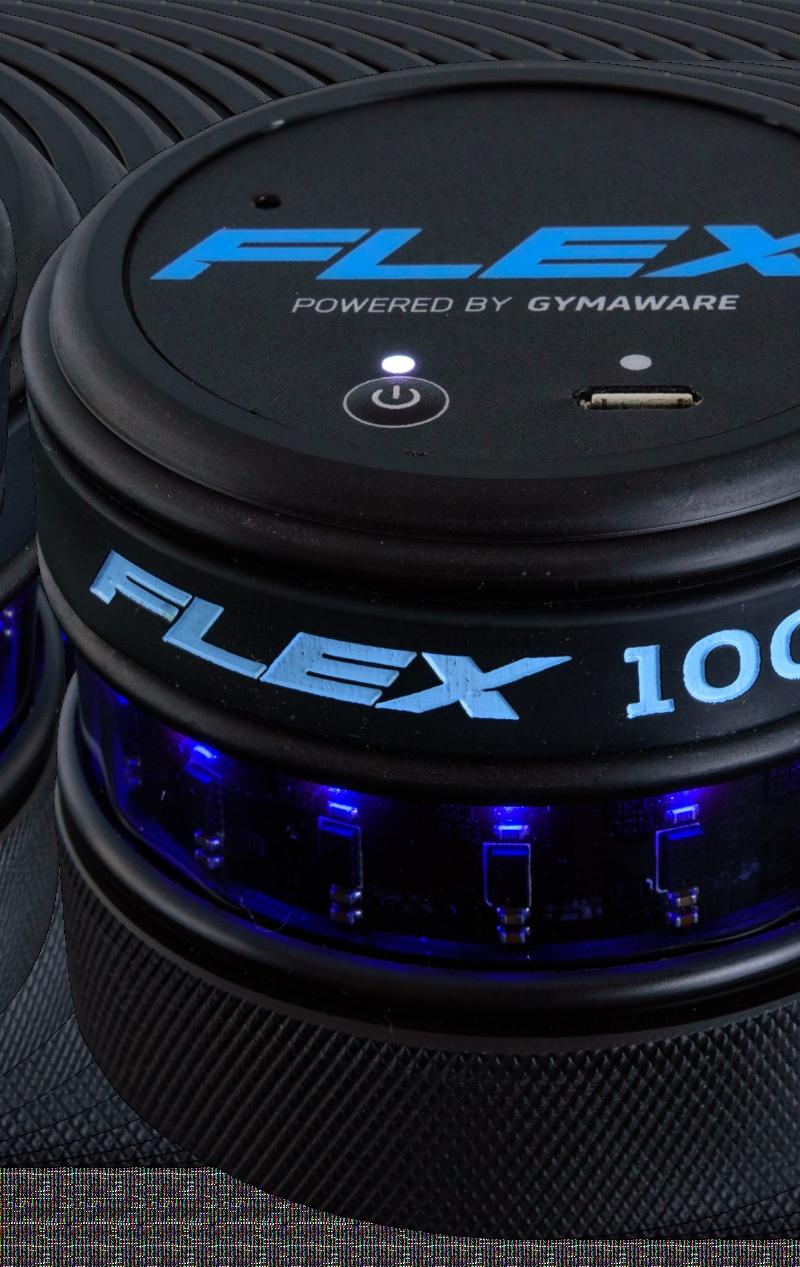
This month’s top research on technology and monitoring.
MONITORING CONSIDERATIONS FOR PRODUCTIVITY WITH NOVICE LIFTE
BARBELL VELOCITY VALIDITY AND RELIABILITY OF PUSH AND SPEED4LIFTS DEVICES

Much of monitoring is an attempt to quantify what we as coaches cannot see, and psycho-emotional measures, such as an athlete’s pleasure or displeasure (i.e. affective valence), can impact the training process. Especially for something that may be new and different for an athlete, like resistance training, capturing athletes’ feelings (i.e. athlete affect) can be a critical component to encouraging productivity and consistency to their physical development (see HERE).

The Feeling Scale (FS) is a measurement tool that has been successfully applied to rating and prescribing aerobic work (positive-negative). And in effort to promote a constructive training experience and improve adherence, it makes sense that it has shown potential to keep loads appropriate with resistance training (see HERE).

Another more common way to measure exertion and quantify intensity during resistance training is through a combination of a rating of perceived exertion scale using repetitions in reserve (RPE/RIR) to anchor what a respective RPE of ‘7’, ‘8’, or ‘10’ represent (3 RIR, 2 RIR, and 0 RIR respectively, see HERE).
Although RPE/RIR shows promise for experienced lifters, validity is limited for use in novices. The objective of this research was to see how RPE/RIR and FS change with progressive loads in novice lifters, using both machines and free-weights with a variety of exercises (e.g. lower and upper body dominant movements).
Twenty-nine subjects (age 18-50) who were considered novice to resistance training (had not participated in a consistent resistance training plan in the past year) completed two sessions under guidance and observation.
One session consisted of four machine exercises (leg press, row, chest press, and leg curl), and the other session was four free-weight exercises (goblet squat, row, bench press, stiff-leg deadlift). Each exercise was learned, and loads gradually progressed over 3-5 sets until the athlete reached a 10repetition maximum (RM).
RPE/RIR and FS were also explained prior and measured for each exercise at the completion of each set through achieving a 10RM. These two variables were examined for relationship and consistency across the sets for each subject in effort to validate their use in practice with novice lifters.
It is important to properly teach the RPE/RIR scale by affirming examples of what a RPE of 8, or 2 RIR, feels like. This should be done for a spectrum of RPE values 7-10, or RIR values of 3-0, but working in repetition ranges of 8-12 to keep loads moderate to begin with, promoting confidence in the initial 3-5 repetitions.
§ Teaching the RPE/RIR system with weights that are too heavy (4-6RM) could create apprehension for initial repetitions and misunderstanding for the proximity to failure (RPE/RIR).
§ Alternatively, attempting to teach the RPE/RIR system with loads that are too light (15-25RM) can be difficult for the athlete to understand and may be inaccurate, as the initial 8-10 repetitions may be too easy or fatiguing in other ways beyond local muscular fatigue (e.g. boredom or distraction).
Coaches can promote consistency by measuring impact at the end of a session. If the affect is low or poor, a coach can follow-up and find out what’s going that may be reducing enjoyment (e.g. the workout, exercises, or outside social factors). This helps build a trusting coachathlete relationship and shows the athlete that the coach cares about their feelings and values feedback.
Although the affect was consistently positive in this study, the novelty of resistance training can quickly wear off as fatigue and soreness accumulate over time. This is why measuring affect consistently across the weeks of training is important to monitor
§ An aspect that likely supported the positive affect found with the subjects in this study was the 2-4min rest periods between sets - this encourages full recovery, promotes better quality, allows for greater training loads and potential progress in strength or hypertrophy
Affect is a summarised measure that is influenced by numerous factors (e.g. sleep, nutrition, psychosocial influences, etc.), all of which can guide the need for training modifications. Measuring it can be helpful, but a coach still needs to do these things during a resistance training session to autoregulate training:
Want
Use of the RPE/RIR scale proved valid for novice lifters, increasing with greater loads relative to a 10RM.
Although FS measures were lower when the set was taken to failure (e.g. 100% of 10RM), they were consistently positive throughout all loads (50%+).
RPE/RIR was relatively lower for upper-body exercises compared with lower-body exercises.
The affect was higher (more positive) for machine-based versus free-weight exercises, and upper-body versus lower-body exercises.
§ Use visual cues relative to an athlete’s demeanour (e.g. energised or not).
§ Promote a positive environment (e.g. verbally encouraging athletes, playing favourable music).

§ Ask for verbal feedback relative to fatigue, soreness, or sport-specific practice went (e.g. open ended questions and conversation).
Failure is an unnecessary intensity for novice lifters, creating an overabundance of fatigue (see ), especially for athletes who are HERE implementing resistance training to supplement their sport-specific development. Athletes can be productive working in the 5-8 RPE/RIR range and still show increases in strength and muscle mass (see ) while concurrently participating in another sport (e.g. HERE soccer, basketball, rugby, etc.).
Based on the higher RPE/RIR values reported for lower-body exercises, coaches should appreciate that lower-body exercises involve greater amounts of muscle mass and promote greater systemic fatigue. Knowing this, volume (both total sets and repetitions per set) should be reduced in season, and longer (3-4min) rest periods should be encouraged when prescribing lower body exercises (e.g. squats, deadlifts and lunges) with RPE’s >7
§ Alternatively, given the above insight, upper body exercises (e.g. presses, rows, bicep, triceps, or shoulders) can tolerate higher volumes and shorter rest periods.
Research does show inconsistency related to measures of affect and machine-based, free-weight, upper- and lower-body exercises. It really depends on the individual and is likely specific to the exercise itself, but the important aspects to consider when introducing any exercise and making an effort to improve athlete affect:
§ Clear and concise introduction of the movement, including a demonstration and primary technical cues to focus on.

§ Appropriate loading (using light to moderate loads until technique and understanding are established).

§ Starting simple and allowing for progression of complexity (e.g. starting with a self-correcting exercise like the goblet squat that promotes an upright posture and encourages the athlete to sit back and load hips and feet properly).
“It is critical for coaches to appreciate why they prescribe certain exercises, how it fits into their athletes’ long-term development, and how they allow athletes to bring up loads and intensity with resistance training. The point to understand when working with athletes is that context is everything. There is not one specific exercise, training method, or training plan that is always going to work - especially when working with athletes who have limited experience with resistance training.

“The important aspect to appreciate with all of this is adaptability; strategically implementing resistance training and encouraging consistent adherence over a period of months can deliver lasting results.
“Whether that’s using the RPE/RIR method or machine-based exercises – what works for one will not work for all and affect is an important aspect to monitor with athletes who may be apprehensive. Gaining athlete feedback and providing them autonomy in their training and development can be a very powerful piece to a more productive training plan.”

Velocity Based Training (VBT) involves incorporating objective measurement of barbell velocity while strength training, providing valuable feedback to coaches and athletes looking to monitor and assess performance.
Use of optoelectronic three-dimensional (3D) motion capture technology is one option for calculating movement velocity that is valid and reliable (see ), but is also very unrealistic HERE to be used in a team-sport setting due to costs and requirements of setup. During the past several years, velocity measurement devices (e.g. inertial measurement units (IMU, see ), linear position transducers (LPT, see ), and HERE HERE laser-based devices (see ) have been developed that HERE make implementing VBT affordable and practical when working with a team.
PUSH Band 2.0 (PUSH) is an IMU device that attaches directly to a barbell and utilises wireless Bluetooth technology for immediate feedback, repetition by repetition. Likewise, Speed4Lifts is a LPT device that attaches a tether to one end of the barbell for similar, instantaneous velocity feedback that can be used to guide workloads (e.g. weights used, as well as sets or reps performed).
Research on these devices has been inconsistent regarding validity and reliability when compared with a criterion measure, and using free-weight barbells instead of a smith machine (see HERE HERE). and Therefore, the purpose of this research was to test the validity of PUSH and Speed4lifts VBT devices, as well as assess session-to-session reliability when performing squats (back and front) and bench press using free-weight barbells at various loads.
Twenty male athletes (age 20.15 ± 2.01 yr) with experience performing back squat, front squat, and bench press completed two assessment sessions with these three exercises.
One repetition maximum was estimated (1RMe) for each exercise using the Brzycki formula from pre-season training data. The two sessions were separated by 6-8 days, and each session consisted of performing the three exercises in random order Athletes performed three maximal repetitions using four progressively heavier loads (i.e. 20%-, 40%-, 60%-, and 80%1RMe) for each exercise. Warm-up, rest periods, and technique were all standardised for consistency with encouragement to ‘perform the concentric phase as fast as possible to full extension for each repetition and exercise.
The wireless PUSH device was attached to the centre of the barbell, examining mean concentric velocity for each repetition; the Speed4Lifts device was attached to the subject’s left side, just inside the barbell collar, examining mean propulsive velocity As well, a 3D motion capture system was arranged using six infrared cameras, examining bar displacement, velocity, and acceleration as the criterion (gold standard) measure.
Data was analysed and compared by dividing velocities into three categories (slow-<0.65 m/s, moderate-0.65-1.00 m/s, and fast->1.00m/s). Velocity measurements for PUSH and Speed4Lifts were compared with the 3D motion capture to assess validity, as well as assessing the reliability of each device, comparing the average and maximum performance at each load between the two sessions.


When using velocity measurement devices, the best way to improve reliability of the measurement is to be as consistent as possible with setup and technical execution of a given exercise (e.g. hand and foot placement, range of motion, eccentric tempo) as well as instructions for an athlete’s performance (e.g. moving the barbell as fast as possible throughout the concentric phase, keeping heels in contact with the ground upon completion of the squat).
Likewise, using the equipment properly and advantageously can minimise variability (e.g. placing the device in the centre of the barbell when using the PUSH band provides a more stable measure of vertical movement). Also, there is a danger of inaccurate measures for strong athletes using heavy loads, as the end of the bar may flex or whip at the completion of a repetition, creating increased variability in velocity and potential error in measures (see HERE).
Given the natural variability associated with technique, especially with a free-weight barbell, in addition to the variability in measurements from imperfect devices, averaging the mean concentric (or propulsive) velocity of three repetitions performed in a set is arguably best practice. Three repetitions in a set allow for the best opportunity to showcase performance ability without fatigue being a factor if performing 4-8 repetitions in a given set, as well as accounts for potential ‘unmeasured’ repetitions that often happen with wireless devices. Coaches should consider favouring mean propulsive velocity, if able, when measuring barbell velocity of a given exercise, as this only accounts for barbell movement that exceeds gravity (-9.81 m/s2) and is a
Want
more accurate representation of performance potential, not taking into account the deceleration phase as the repetition finishes. Alternatively, when measuring total mean concentric velocity (the entire upward acceleration and deceleration phase of completing a repetition), this value will be depreciated because of the deceleration phase required when approaching lockout, providing an inferior metric when compared to concentric propulsive velocity only The deceleration phase is inevitable with the bench press, as an athlete is unsafe to release the barbell when aggressively locking out the bar, and if athletes are coached to keep their feet in contact with the floor when finishing a squat, there will be obvious deceleration that occurs to prevent the barbell from leaving the shoulders. This not only provides a better representation of ‘propulsive’ performance, but also works to reduce injury risk associated with an overt focus on generating maximal velocity for the concentric portion of a repetition.
When comparing results between sessions and understanding meaningful change in performance, it is important a coach understands the variation in results (i.e. minimal detectable change, which is calculated from the standard error of measurement). These values were typically higher with lighter loads and higher velocities, but smaller with heavier loads and slower velocities.
Overall, although the validity of measurements with PUSH and Speed4lifts devices is questionable, especially at higher velocities; the reliability and practicality of use with the majority of loads (60-80%-1RMe) and traditional velocities (0.3-1.0m/s) that occur with squats and bench press is generally acceptable. Use it as feedback to help encourage intent and competitive effort in a team setting, as opposed to a hard-pressed and isolated decisionmaking monitoring (e.g. making changes based on velocity results alone) or assessment tool.
When compared with 3D motion capture:
§ Mean concentric velocities reported by PUSH were valid for slow velocities (<0.65 m/s) for all three exercises (back squat, front squat, and bench press), as well as for moderate velocities (<1.00 m/s) in the back squat.
§ Mean propulsive velocities reported by Speed4lifts were valid for moderate velocities (0.65-1.00 m/s) in the back squat and bench press, as well as slow velocities (<0.65 m/s) for back and front squats. Using the average of the three velocity measures performed in a set helped to reduce variability in measurements.
Based on load (20-80%-1RMe) reliability, averaging measures for the set:

§ PUSH was reliable for all loads in the back squat, and most loads (40-80%-1RMe) in the front squat and bench press. However, front squat and bench press at 20%-1RMe were unreliable.
§ Speed4lifts was similar, arguably better (more reliable), as only 20%-1RMe with bench press was found unreliable. All other loads and exercises were consistent session to session.
"The important piece for me regarding VBT and the validity and reliability of devices, is that reliability is not a reflection of the technology alone. We have to also appreciate the freedom of movement that is allowed with a free-weight barbell exercise and the inherent variability in a movement based on numerous factors, range of motion being a primary one, as well as the innate movement of the barbell under load. Simply put, no two repetitions are completely alike, but similar, nonetheless.

“Where I think velocity-based, live-feedback measurement devices have the greatest return is that it encourages a concentric action to be more than simply standing up or locking out the barbell. VBT has shown to be an effective tool in increasing performance (see ), simply due to the HERE accountability offered by a measurement.
“There are likely more accurate and practical ways to objectively measure performance than with an IMU or LPT device (e.g. force plate or sprint time), as using barbell exercises for monitoring carries inherent variability for a team-sport athlete, being unable to identify fatigue or meaningful change. A given load (e.g. 70%-1RMe) is likely to move in a given range (e.g. 0.6-0.7 m/s). Rather than getting caught up in objective specifics, let’s aim to maximise the opportunity these devices allow. Do not limit or restrict athletes based on the results of velocity measures, but rather simply encourage athletes to do their very best and provide them with reliable feedback.”

This month’s top research on fatigue and recovery

HOW DO SLEEP PATTERNS COM
BETWEEN ELITE ATHLETES AN GENERAL POPULATION?
WHAT ROLE DOES FATIGUE, MU ACTIVATION AND FUNCTION H HAMSTRING STRAIN INJURIES?
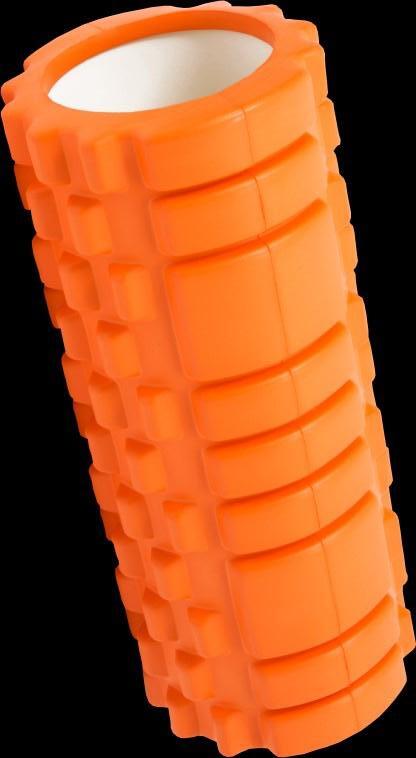
Elite athletes are known to have suboptimal habitual sleep patterns, often due to situational challenges to sleep including travel demands, practice and competition schedules within season.
The present study compared the challenges that athletes face with sleeping as compared to age-matched subjects in the general population. With this, recovery and quality of sleep were studied to determine any correlation between the location of where sleep took place along with days surrounding competitions.
41 female participants were studied; 11 elite basketball players, 10 elite soccer players and 20 age and sex matched nonathletic controls. Sleep and recovery were monitored over four 7-day periods throughout preseason and competition season for the athletes. The control participants were studied over four 7-day periods as well.
Data collected was taken from the athlete s subjective sleep diary along with a wearable activity monitor to determine when participants were awake and asleep. The sleep diary took information about post-sleep fatigue, sleep quality and perceptual recovery using the Perceived Recovery Status Scale.
The following variables were studied from the activity monitor along with the diary:
§ Bedtime: time when participants attempted to sleep
§ Wake time: time when participants got out of bed
§ Total sleep time: amount of time spent asleep
§ Sleep efficiency: percentage of time asleep while in bed
§ Wake after sleep onset: time spent awake after the onset of sleeping
§ Sleep onset latency: time between bedtime and sleep onset
§ Postsleep fatigue: self rating from fully alert to completely exhausted




§ Sleep quality: self rating from very good to very poor
§ Perceived recovery status: self rating from very poorly recovered to very well recovered



The present study shows how the elite female athletes suffer from suboptimal sleep patterns when compared to age-matched controls. Some causes contributing to this include competition/practice schedules, unfamiliar sleep locations and stress related to competition.
Elite female athletes would benefit from in-season sleep screening and medical assessment to individualise their schedules around competition and improve sleep habits. With this, coaches and trainers can better adapt to this issue by scheduling later practices the day of and after competitions.

When able to, teams should go home directly following away games to allow players to sleep in a familiar setting.
Coaches and trainers should also encourage napping during the day and protect sleep schedules around competition periods.
Avoiding early morning practices and meetings are also good strategies to improve the likelihood of improved sleep.
Results showed that both the basketball and soccer players scored worse with the following variables when compared to the control group: wake after sleep onset, sleep efficiency, sleep onset latency and recovery. Post sleep fatigue had a lower value but was not statistically significant. In addition, both sport groups had longer sleep durations following home games compared to away games.
Along with this, the basketball athletes slept least the day of the game and the most the day after the game when compared to the soccer athletes. When looking at both athletic groups along with the control group of non athletes, the soccer players demonstrated the poorest habitual sleep patterns and slept the shortest amount of time.
“Sleep is vital to an athlete's success and is too often pushed aside in season for preparation for competition.
“Coaches can take it upon themselves to do right by their players by adjusting schedules around competition to prioritise sleep. Scheduling later-morning practices, and travelling home following away matches are some of the ways to improve the likelihood of better sleep.
“Continuous monitoring of an athlete's sleep is important to track throughout the season as it can be a strong indicator of performance. Some examples to try may include keeping sleep journals and having weekly check-ins with athletes regarding their progress.”
Hamstring strain injuries (HSI) are one of the most common types of injuries which often occur during highspeed running. HSI rates are particularly high in soccer, accounting for 37% of all muscle related injuries (see HERE).
However, one larger issue is the continued high recurrence rate for injury which can range anywhere from 12-33%. Some reasons for a high re-injury rate include lack of strength and neuromuscular fatigue among others. Minimising the risk of injury is a main focus point in both rehabilitation as well as strength & conditioning programs.

The aim of this review was to investigate the mechanisms of hamstring strain injury as well as the interaction between fatigue, muscle activation and function with injury risk.
This critical review analysed the mechanisms of HSI during high intensity running, and discussed the relationship between the state of fatigue and its impact on hamstring muscle activation and function.

Two types of HSI were presented (1) stretch-type vs. (2) sprint-type along with a breakdown of hip and knee biomechanics during high-speed sprinting.




Injury susceptibility is greater during the late swing phase of sprinting, so targeting the biceps femoris long head through exercises like the stiff-leg deadlift is important as the angle of the hip produces a greater impact on biceps femoris long head length than the angle of the knee. Hip flexion-extension exercises cause more biceps femoris long head recruitment compared with fixed hip movements.
Fatigue causes decreased lower limb stiffness as well as reduced movement efficiency resulting in increased joint stress, so training in a fatigued state is an important aspect to help prepare athletes for the demands of sport and decrease the risk of injury
Strengthening the hamstring musculature at longer muscle lengths may be beneficial in reducing injury risk as force absorption capacity may be reduced at these lengths.
The stretch-type of HSI occurs in movements involving a combination of extreme hip flexion and knee extension (e.g. kicking and dance manoeuvres) which seems to occur at long-muscle lengths primarily affecting the semimembranosus.
The sprint-type HSI occurs during maximal or nearmaximal running actions working within the normal range of the muscle, primarily affecting the long head of the biceps femoris.
A complete running cycle includes two main phases: the stance phase and the swing phase, which can be divided further into sub phases: early stance (braking), late stance (propulsion), early and middle swing (recovery) and late swing (pre-activation).
As running speed increases from 80% to 100%, biceps femoris activity, during the terminal swing phase, increases an average of 67% which can increase the risk of injury; while semitendinosus and semimembranosus only showed a 37% increase.

HSI may also occur during the early stance phase as the ground reaction force causes a large extension torque at the knee and flexion at the hip. In order to counteract this, the hamstring muscles need to produce large flexion torques at the knee and extension torques at the hip, placing them under high load.
Fatigue is a key factor in relation to HSI, as fatigued muscles are able to absorb less energy before reaching the stretch limit which may directly increase injury risk.
Biceps femoris is activated earlier than semitendinosus to prepare for high-impact moments at foot strike when running close to maximum speed, noting the importance of the biceps femoris in the generation of forward propulsive force.
An earlier peak activation time during the late swing phase of sprinting was seen in the semitendinosus compared to the biceps femoris, while an earlier peak activation time in biceps femoris compared to semitendinosus was seen during the stance phase.
These differences in activation pattern displays the neuromuscular coordination required during the running cycle as speed increases, which may exert an influence on injury risk.
“Although we can’t prevent injury, the number one cause of injury is previous injury With the continued high rate of recurrence of HSI, we must question our rehab processes to ensure we are fully preparing athletes to handle the demands of their sport upon return.
“Proper progression on a return-to-sprinting programme, along with objective measures addressing strength, endurance, power and energy systems development, are all essential and non-negotiable aspects of rehab.”
This month’s top research on youth development.
CAN INSTABILITY TRAINING BEN YOUNG ATHLETES? AN INVESTIG UNSTABLE VS. STABLE SURFACE

HOW MUCH IS TOO MUCH? AN INVESTIGATION OF THE DEMAND YOUTH FOOTBALL AROUND GRO AND MATURATION
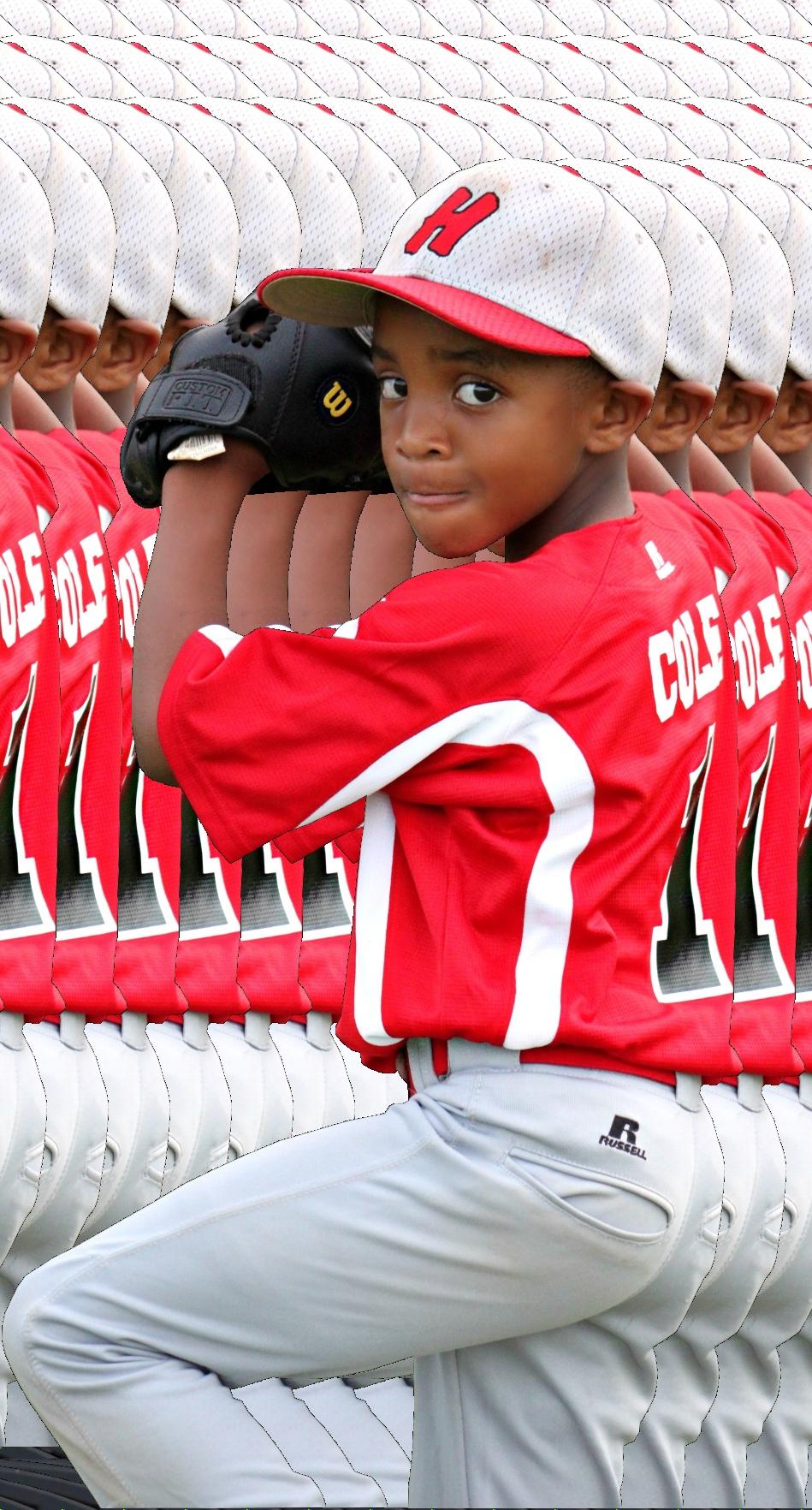

In soccer, athletes must have high levels of power, speed, change of direction and dynamic postural control to perform at a good level. These factors are not only critical for performance, but are essential as injury preventatives.
One of the common training interventions to develop these qualities is strength training. However, these are often conducted on stable surfaces. Recently, the inclusion of unstable surfaces, such as a BOSU ball or foam pads, have been added to strength training programmes, as these are thought to recruit muscles at a faster rate, increase co-activation between the trunk and lower-limb muscles, and increase slow and fast-twitch muscle activation.
However, few studies have compared stable vs. unstable surfaces on selected measures of physical performance. Therefore, the aim of this study was to compare the effectiveness of two programmes in youth soccer players.
Eighty-four U19 soccer players who were competing at a national level agreed to participate in this study
Inclusion criteria required participants to have had a background in soccer for at least four years, continuous exposure to soccer training for the previous three months, an absence of lower body injury within the last two years, and the absence of any medical problems.
Of the 84, only 55 participants met these criteria. Participants were placed into either an unstable resistance training group (n=27), or a stable resistance training group (n=28). Pre and post-test were collected for horizontal jumping (dominant and non-dominant leg), repeated sprint ability, Illinois change of direction test, and aerobic endurance test (YoYo Level 1).
The resistance training was performed bi-weekly for 10weeks, consisting of a bent-over row, forward lunge, front half-squat, prone leg curl, overhead press, and calf raise exercise.
Athletes in the unstable group performed all exercises on a BOSU ball, whilst the stable group performed these on a hard surface.


Coaches who are working with youth athletes should consider implementing unstable surface training to develop physical qualities in youth related to sprint training. In the current study, the technical staff valued the intervention as it followed the warm-up twice a week and lasted only 15-20 minutes. In addition, it is worth noting the players thoroughly enjoyed the challenge of training on an unstable surface. Simple additions to your programme could include; a front raised BOSU lunge, BOSU raised side plank, and a ‘stir the pot’ exercise on the BOSU (HERE). Additional exercises can be seen in the attached video.
Whilst the lack of adverse responses to training on an unstable platform is encouraging, coaches should be aware of the health and safety considerations of training on such a surface. For example, this study utilised weights at a relatively low percentage of a one-repetition maximum (6065%) with low session volume. At 19, football players can easily have 4-5 years of training age, so higher loads may need to be used for more conventional lifts (e.g. heavy squats, Olympic lifting variations, and Deadlifts). To advance training, coaches should think about unilateral variations of lifts (e.g. offset BOSU squat), ipsilateral variations (e.g. rear foot elevated BOSU lunge with single-arm overhead press), or adding resistance bands to common movements. Another useful strategy is to add/limit the amount of air in the BOSU ball, where less air is associated with more instability This is thought to increase cocontractions and antagonist activity due to higher requirements for balance/stability as discussed in the attached article.
When looking to introduce exercises on an uneven surface, I would place these in a warm-up to supplement activation exercises until adequate stability is developed. Unstable surfaces may progress from barefoot, yoga mats, foam blocks, and BOSU balls. Some of the earlier alternatives may be ideal for those under financial constraints as in some cases they are free/cheaper than a BOSU ball. These air cushions for example are a cheap alternative for younger athletes (HERE). To aid learning, I would try to couple a stable and unstable version of the same exercise (e.g. a bilateral squat on a hard, and unstable surface) as a form of contextual interference to aid skill acquisition (HERE).
Resistance training performed on unstable conditions was effective in youth looking to improve repeat sprint ability. In particular, maximal linear sprinting and the ability to sustain high sprint speeds was improved under the unstable condition.
Regarding jump ability, no significant interactions were shown in the triple hop test, with both the dominant and non-dominant limb. This suggests resistance training on stable and unstable surfaces had little to no impact on horizontal jump ability
Performing training on an unstable surface for 10 weeks, twice a week was more advantageous than training on a stable platform when performed at 60-80% of one repetition maximum (1RM).
“Based on the findings in this study, coaches should look to integrate resistance training exercises on unstable surfaces to improve linear sprint speed and repeat sprint ability. In order for the benefits to apply to change of direction and agility tasks, the authors suggest coaches need to look at implementing training in multiple directions (e.g. horizontal, vertical and lateral). In addition, coaches must drop their biases surrounding unstable training, as the results of this study clearly show this can be an effective tool for athletic development.
“In programming, balancing both stable and unstable surface training may be advantageous to athletes. Training on a stable surface is renowned for increasing ground force reaction and rate of force development (HERE). Unstable surfaces are prominent in rehabilitation programmes, as these increase muscle activation with lower force demands as discussed by Paul Venner in the attached podcast. In this podcast, Paul adds to the rationale, suggesting unstable surfaces present an ecologically valid condition for soccer players, as they often train on muddy surfaces which are uneven in nature.


“In addition, Paul directs the listener to the requirement for dynamic stability during jumping, landing, and physical bouts (i.e. shoulder to shoulder challenges) to prevent injuries in soccer This, coupled with the findings of the reviewed study, build a compelling argument for their inclusion in a programme.”

Football clubs invest a large amount of capital into their academy programs to develop talented youth players. In order for a player to stand out and progress through the system, they must be exposed to regular training and match play According to Jones (2019), the likelihood of a high-level youth player sustaining an injury that results in time-loss from training is around 50%. In addition, between 53-72% of these are thought to be non-contact injuries. To add to this, maturation can increase the likelihood of injury due to both physical and sensorimotor adaptations.
To date, few studies have evaluated the relationship between exposure, injury risk and maturation in youth football players. Therefore, the aim of this study is to explore the interactions between exposure, growth, maturation and injury in elite male academy players.
Forty-nine elite male youth footballers (U13-16) were recruited for this study from one professional English academy. Players' stature, mass, chronological age and mid-parent stature were predicted using data collected from parents through a self-report. An equation was used to negate over-estimation of height, allowing the subjects to be placed into pre, circa, or post peak height velocity (PHV) using the Khamis-Roche method. From this data, maturity timing was also calculated (early, on-time and late).
Exposure was calculated as the time spent in total training, playing a match, or participating in a gym session at the club. Time-loss injuries were collected on the clubs online database and were defined by a player being unable to take part in training or match play Again, only injuries that occurred at the club were counted.

Considering the association between PHV, growth and exposure, coaches must look to address all three of these in training. Firstly, tracking PHV is a relatively simple process depending on the method used. A copy of an excel template for PHV and Maturity offset can be found HERE. When working with youth, I would advise tracking PHV measures four times a year The measurements you need to take are standing height, seated height, and weight. A video of this process can be seen HERE. An important factor to consider for this is gender. For example, females on average go through the PHV process at approximately 11.5 years of age. However, in males, this is a bit later at 13.5 years (HERE). Therefore, gender-differences in monitoring may need to occur within your organisation/club. Some additional considerations surrounding the reliability of these methods can be seen in the attached video.
A limitation of this study is that the types of locations and injuries were not analysed. In the attached article which investigated injury statistics in elite youth male football players, the most common injury sites were the thigh (23%), knee (17%), ankle (17%), and hip/groin (9%). Again, these were mostly noncontact injuries, suggesting interventions to strengthen key muscles and joints could be useful as preventatives. In an ideal environment, clubs would pursue this year-round. However, high-risk phases of adolescence (pre/circa-PHV) are of importance. In the past, the FIFA 11+ injury prevention programme (HERE) has had great success, as the programme is developed to target common injury sites. If clubs are not in a position to commit to this standard of injury prevention, I would advise a simple circuit consisting of:
1. Walking overhead lunges (3x10 metres) HERE. Walking lunges are a fantastic exercise in developing stability in overhead positions, whilst challenging balance, ankle mobility, trunk alignment, and
2. Dynamic inchworms with single-leg kickbacks (3x10 metres) HERE. This exercise is fantastic for developing hamstring mobility and hip extension.
3. Double/single-leg pogo jumps (3x10 metres) HERE. These should come at the end of this circuit and are great at getting the foot ready for sprinting and accepting force.
Finally, coaches and sports scientists must make more of an effort to monitor exposure during a season. This should include and not be limited to any other club/school fixture that individuals take part in. A simple Google sheet or frequency questionnaire should be sufficient. With this data, youth could be tracked for periods of heightened exposure, which is related to injury. In addition, and depending on the level of support, rate of perceived exertion (time x RPE) or Global Navigation Systems (e.g. total distance, high speed running etc.) can be a great way to understand the internal and external training load of the team.
In total, there were 53 injuries and 8,843 hours of total exposure. The mean exposure for each player was 180.4 (± 40.6) hours. The mean severity of injuries was 31 days.
This study found the relationship between a higher growth rate (92-95% of PHV) and the likelihood of injury was greater As a result of this, the U16’s age group had the lowest injury burdens. =
More specifically, growth rates of >7.2cm/year were a strong predictor of injury The peak injury burden occurred at 4.17cm/year, which was strongly associated with moving from pre-PHV to circa-PHV
When investigating weekly exposure, the authors found that week-to-week changes in exposure were associated with injury This study found that an increase in weekly exposure of two standard deviations, which equates to roughly 235 minutes, increased injury risk by 168%.
“Overall, this study brings attention to the need for coaches, teachers and sports scientists to make informed and educated decisions surrounding the training process and the impact that growth, maturation and exposure have on injury likelihood. This is increasingly important given the demands that clubs place on youth to represent them in numerous training and match fixtures throughout a season.
“When considering exposure is strongly related to injury, the ideal solution is that clubs would provide periods of respite from training to allow for total recovery, both physical and psychological. However, given the ruthless pursuit of talent, coupled with the systemic issue in football that ‘more is better’, a lot more education to coaches and parents is required as to the importance of rest and recovery This should have no bearing on selection, but unfortunately, this is much easier placed in writing than in action. An excellent video highlighting these issues can be seen HERE.
“In conclusion, coaches should adopt strategies that focus on monitoring training load and intensity whilst addressing some of the key injury sites in youth. The attached podcast by Martin Wollin PhD addresses this in great detail, providing both practical solutions to the ‘monitoring and training’ conundrum. Martin draws on his years of experience, highlighting some of the issues in the monitoring process, whilst providing some practical solutions to combat common injury sites.




“As a coach, exposure and maturation should be tracked to ensure that youth are able to showcase their talent with minimal risk to their health and wellbeing.”

This month’s top research on nutrition
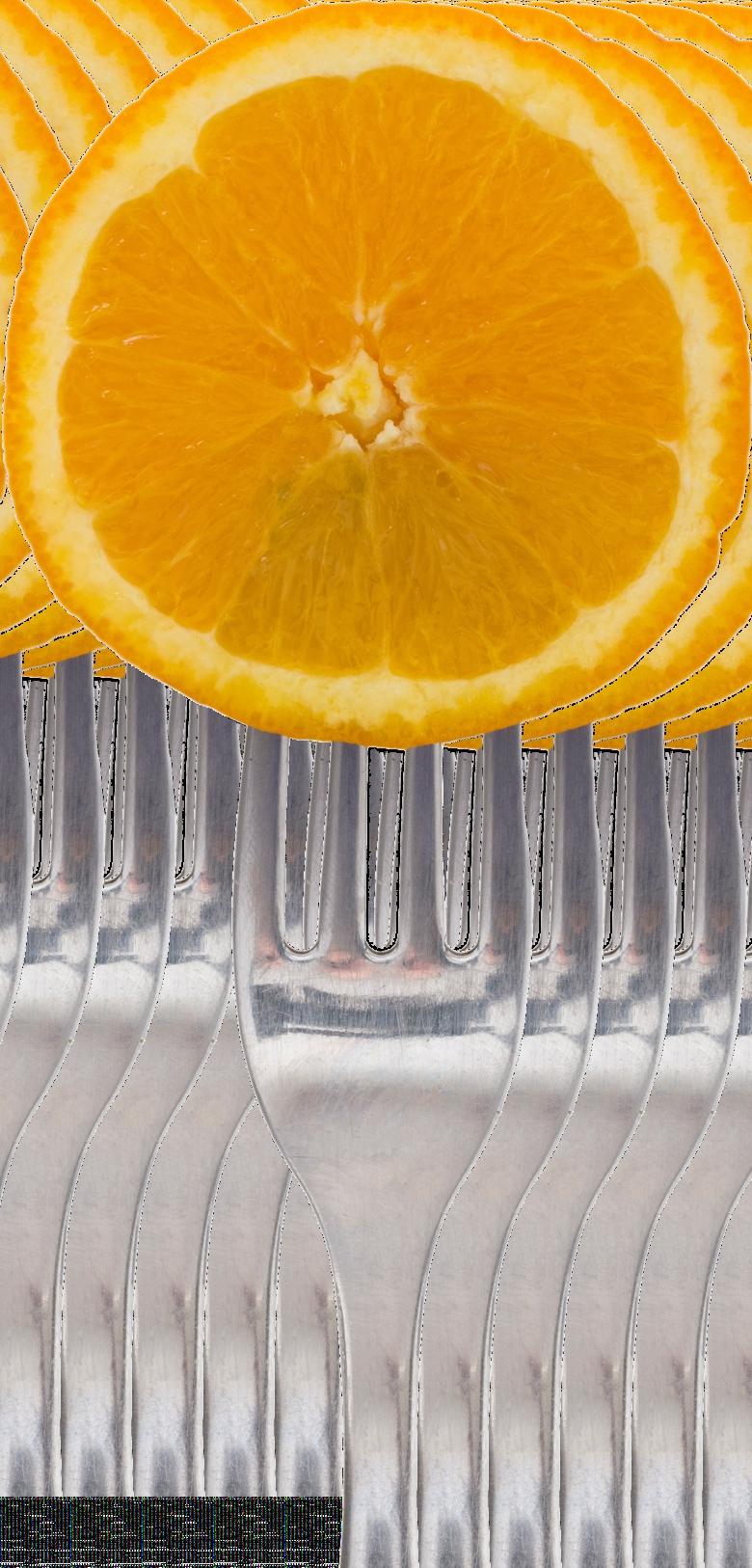
NUTRITIONAL SUPPORT DURING A PANDEMIC: ADAPT TO SURVIVE
INTENSE WEIGHT CUTS IN MMA: A RITE OF PASSAGE OR THE WRONG IDEA?
CAN POLYPHENOLS AND SALT CREATINE COMPLEX INCREASE MUSCL STRENGTH AND POWER?


Over the past few years, COVID-19 (and subsequent lockdowns to prevent the spread of the virus) has caused lots of disruption to professional sport. In football, it has been reported that lockdowns have led to detrimental lifestyle changes for both players and those who support them. It’s reasonable to assume these changes may have impacted health and performance. A recent position statement has proposed recommendations for professional football players returning to play after lockdowns or disruption as outlined in the related article. However, this article did not include any recommendations on nutrition.
It has long been known that a football player's nutrition plays a key role in their health and performance. Current nutritional recommendations for professional football players can be found here.
The purposes of this article were to understand how COVID-19 restrictions have impacted sports nutritionists’ practice, evaluate the players’ concerns of this and the support they received, before using these perspectives to inform nutrition practices when transitioning from restrictions back to normality
This study consisted of multiple semi-structured interviews designed to collect qualitative data on both sports nutritionists and professional football players’ experiences during the COVID-19 pandemic. The paper did not include any detail on the order of questions in the study but did ask participants to respond in their own context and consider their own practice or support received.
Twelve sports nutritionists currently working within professional football in England along with 12 male football players currently playing in the under-17 or under-21 teams of an English Premier League club were included in the study The players had been exposed to nutritional support for an average of six years.


The interviews were recorded, allowing thematic analysis to be carried out afterwards with themes being independently reviewed before being agreed upon.

Three higher order themes were identified across the interviews: ‘sub-optimal nutrition provision’, ‘reduction in effectiveness of support and time/access to players’, and ‘adaptation of nutrition practice and dietary habits’
In the context of the first theme, practitioners detailed how due to the closure of canteens, prepackaged and portioned meals were used for posttraining meals. This led to limited options and perceived reduced quantity and quality of food. Practitioners also shared how it was harder to individualise energy intake for each player These feelings were echoed by the players.
Due to government guidance of ‘working from home’, the practitioners detailed limitations in the types of nutritional support they could provide to players. Some also experienced a reduction in contracted hours and salary. Meanwhile, players reported a loss of face-to-face contact with nutritionists, and they perceived this had a negative impact on their habitual dietary habits and behaviours.

However, the practitioners also detailed that due to having to adapt the way they worked, it led to them considering novel strategies to continue offering support effectively. Many practitioners detailed how their online support sessions were found to be relatively effective. The players also suggested that due to restrictions placed on restaurants, their dietary habits improved over the pandemic with learning how to cook at home being an example.


Despite the adaptations practitioners were forced to make during COVID-19, it’s clear that nutritional support for players was impacted. This is mainly due to the accessibility of food at facilities and the need to move to pre-packaged foods. This point clearly highlights how important it is for athletes to have access to good-quality nutrition options in professional sports clubs to support training adaptations. However, should more restrictions occur, practitioners should seek to improve upon pre-packaged meals used previously, and consider how to individualise these more. For example, seeking the use of professional meal prep companies and setting up partnerships with local chefs who may be able to cook for local players.
Education on dietary habits to improve health and performance is something that can and should still be carried out regardless of restrictions as shown by the adaptation to online support sessions. Although face-to-face access is still perceived as more useful for players, remote learning is ultimately better than nothing.
Due to the previously highlighted detrimental effect on players’ physical and mental health that COVID19 restrictions may have had, it is important for nutrition practitioners to be able to assess an athlete's health, performance, well-being and
nutritional status. With fewer restrictions, individualisation of an athlete s nutrition is easier to execute and should be carried out based on athlete 11’s and put into practice as soon as possible. For example, periodising individual nutrition intake in line with training and competition demands.
“Over the past few years, athletes and practitioners have been forced to adapt. However, the gradual return to normality has also resulted in some readaptation. It is important for practitioners to remember key methods of education and techniques which have worked during lockdowns and where translatable put these into practice when back face-to-face with players. For example, if a presentation on protein intake worked well remotely and the way you delivered it landed well, this will probably be even better in person.
“Mentally, many athletes and staff members would have struggled during the pandemic. Eating and food can be a very positive occasion and so the social aspect of nutritional support should be amplified. For example, make use of the dining rooms, encourage players and staff to communicate and catch up with each other and 1-1’s should be done over a hot drink to build rapport again. This is something that we have been sorely missing and that can have a huge impact on an athlete's wellbeing.”
Mixed martial arts (MMA) is a combat sport that has gained significant amounts of popularity in recent years. Like most combat sports, it uses a weight class system to categorise athletes into different competitive weights.
Normally athletes must weigh in 24 hours before a fight, after which they then follow nutritional strategies to regain as much mass as possible before competition. It’s been reported that up to 95% of MMA athletes engage in a weight cut. The idea for many fighters and coaches is that an athlete who trains at a higher weight could retain their strength and power through a weight cut meaning they enter a fight with greater force producing capabilities than their opponents.
Previous studies in wrestling have shown those who cut more than 5% of body mass were more likely to place in the top four at a tournament compared to those who cut less than 5% of body mass. However, this has not yet been studied in MMA.
This study sought to identify a relationship between the outcome of a fight and magnitude of body mass lost during a weight cut. They also compared results with the amount of body mass regained post weigh-in.
Seventy-five active MMA fighters were included in this study, of which, 59 competed at the amateur level and 16 at the professional level.
The weights of these athletes were recorded at three separate times:
1. before they participated in a weight cut seven days prior to a fight
2. when they weighed in 24 hours before the fight
3. immediately before a fight.

This allowed the researchers to calculate percentage body mass lost across the weight cut and the percentage of body mass regained in the 24 hours before the fight.
They then analysed changes in body mass against the outcome of fights. These outcomes were split into: A win, a loss by knockout or technical knockout, a loss by submission, or a loss by the judge’s decision.



Although this is only one study, the results suggest that too large of a weight cut may impact an MMA athlete s performance and thus the outcome of a fight. A primary method of carrying out a weight cut is that of manipulating water content in the body and energy intake. It is likely a larger weight cut puts the athlete in a state of hypohydration, which has previously been shown to impact an athlete's performance.
Additionally, it makes sense - the more stress placed on an athlete s body pre-fight, the higher chance they have of a poor sleep, feeling fatigued and therefore not in an optimal position to perform. From my own work with combat sport athletes, the smaller the weight cut the better the athlete performs during the fight.

However, in MMA, intense weight cuts are often seen as a “rite of passage” leading to athletes cutting more weight than is necessary. Practitioners should seek to educate athletes on the detrimental effects of this and control any weight cuts by gradually reducing body mass over time, rather than trying to do it in a short space of time.


When carrying out a weight cut with combat sports athletes, practitioners should use evidence-based guidelines around the timing, composition, and quantity of intake to carry out a safe and effective weight cut. These recommendations can be found in the related article below
When regaining weight post weigh-in, practitioners should seek to use individualised rehydration and fueling plans with athletes that have been practiced prior to competition and agreed on by the athlete.
Of the 75 athletes taking part in the study, 38 won their fights. Of the 37 who lost, 17 of these were by knockout or technical knockout, 12 by the judge’s decision and eight by submission.
On average, those who won were found to significantly cut less body mass (8.6%) compared with those who lost (10.6%).
Of the athletes who lost their fights, there was no significant difference in total body mass lost and between the way of losing the fight (i.e., judge decision or knockout etc).
All athletes regained significant amounts of weight inbetween the weigh-in and the fight, however there was no significant difference in weight regained between those who won and those who lost - 6.8% compared to 7.4% respectively
“In MMA, there almost exists a culture of suffering, it’s something colleagues of mine have witnessed in practice. These athletes will sometimes purposefully make a weight cut significantly harder than it should be so they can enter a fight with a perceived mental edge on their opponent as they have ‘suffered more As with any culture, it is something that is going to be hard to change, however more studies like this one, better educated practitioners and athletes more willing to change will, I hope, result in a culture shift that not only improves the safety of athletes but also the standard of the sport.
“Additionally, athletes should be sensible and allow themselves more time to gradually manipulate body composition favourably and make the weight easier.”


Creatine is a naturally occurring protein that can be made endogenously in the body from amino acids arginine, glycine, and methionine, or obtained exogenously from meat and fish or taken in higher doses as a supplement.
Supplementation increases muscle creatine stores, increasing the availability of phosphocreatine to allow for an accelerated rate of resynthesis of adenosine triphosphate (ATP) during and following high-intensity, short-duration exercise. Chronic supplementation of creatine has been shown to increase muscle mass, muscular strength and power due to an improved ability to perform high-intensity exercise, promoting greater training adaptations and muscle hypertrophy
The most common form of creatine is creatine monohydrate. Alternative forms of creatine have been proposed to improve creatine s bioavailability. One example is salt creatine complex. Salt creatine complex has been proposed to improve creatine’s stability and solubility in solution due to the lower pH value than creatine monohydrate. Improved bioavailability could lead to greater increases in exercise performance when compared to creatine monohydrate. However, at present there is not enough clinical evidence to support these claims.
Blueberries are a form of polyphenols, containing high levels of anthocyanidins and flavanols. Anthocyanidins and flavanols are types of flavonoids, which have been proposed to have performance-enhancing effects due to their antioxidant and anti-inflammatory properties. Research on blueberry extract has shown health-promoting benefits, however limited studies have been conducted to assess its effects on exercise performance.
This study investigated the effects of a creatine and blueberry extract combined supplement versus a creatine supplement and placebo on muscular strength, power, and endurance.
Thirty-three recreationally trained men participated in this double-blind, placebo-controlled, parallel study. Participants were randomly assigned to consume a phosphocreatine disodium salts plus blueberry extract supplement (5g phosphocreatine disodium salts; 200mg blueberry extract), creatine monohydrate supplement (3g creatine monohydrate), or a placebo (microcrystalline cellulose) for 28 days.
Measurements of peak torque, average power, and per cent decline of peak torque and average power were assessed before and after the 28 days of supplementation. After five minutes of warm-up on a cycle ergometer at 50W, participants were seated on an isokinetic dynamometer They performed a fatigue test of 50 maximal, unilateral, concentric, isokinetic leg extensions at 180°.s-1. Peak torque and average power were measured as the mean values from the first three repetitions. Percent decline of peak torque and average power was measured as the percentage decline from the mean of the first three repetitions to the mean of the last three repetitions. Assessments of body mass, dietary intake and exercise were conducted to ensure no significant differences between participants included in data analysis.




The results of this study suggest chronic blueberry extract and salt creatine complex supplementation may increase lower limb muscular strength and power, but not endurance, in recreationally trained males.
However, practitioners should avoid recommending blueberry extract or salt creatine complex supplements to athletes based on the findings of this paper, since this is the first study to assess the effects of chronic blueberry extract and salt creatine complex supplementation on muscular strength and power

Since blueberry extract and salt creatine complex were combined in the experimental group, it is unclear whether one of or both compounds influenced increases in quadricep strength and power
Furthermore, participants in this study were recreationally trained, which may account for increases in quadricep strength and power in the placebo group. Future studies should replicate this study to determine the effects of blueberry extract and salt creatine complex supplemented separately on changes in muscle function in trained and untrained male and female populations.
Although the participants’ diets were assessed to determine any differences in calorie and macronutrient intake, they were not controlled or assessed for differences in polyphenol intake through foods, which may have influenced the results of this study
Research has also suggested supplementation of high dose antioxidants, such as polyphenols, could interfere with skeletal muscle adaptations to exercise training.
Practitioners should instead adopt a food-first approach. Encouraging athletes to “eat the rainbow”, specifically from fruits such as mixed berries, will provide sufficient doses of polyphenols. Alternative sources of polyphenols such as teas, herbs, spices, and cocoa may also be recommended. A practical recommendation is to aim for five different colours of fruit or vegetable across a day, with two different colours at each meal, allowing adequate consumption of antioxidants and polyphenols without danger of blunting training adaptations.
Ensuring athletes are adequately fuelled and rested before exercise should be the primary focus for athletes looking to maximise muscle strength and power

Where diet alone is unlikely to allow for full saturation of muscle creatine stores, creatine monohydrate supplementation may be considered. The beneficial effects of supplementing creatine monohydrate in addition to diet on muscular strength and power are well established. Conversely, the efficacy, safety, and regulatory status of other forms of creatine, such as salt creatine complex, have not been well established. Therefore, until this scientific backing is established, practitioners should only recommend the use of creatine monohydrate.

Peak torque increased significantly for the phosphocreatine disodium salts plus blueberry extract supplement (PCDSB) group (+19.3%) and creatine monohydrate (CM) group (+12.0%), but not for the placebo group (+77%).
Average power increased significantly for PCDSB (+21.3%) and CM (+11.4%), but not for the placebo group (+6.2%).
There was no significant change in per cent decline of peak torque and average power across all groups.
“Supplement companies often overhype new supplements such as salt creatine complex and blueberry extract. These are likely to receive greater attention than supplements we already know to have considerable scientific backing, such as creatine monohydrate.
“Lack of research or scientific backing on both the efficacy and safety of new supplements can present a risk to the athlete's health if used. Lack of testing for prohibited substances under certification programmes such as Informed Sport increases doping risk and subsequent bans from competition. Athletes should be reminded of these risks."

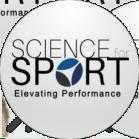


The next issue will be published on the 1st of next month.
Did you like all the great content in this issue?
If so, then make sure you spread the knowledge with your friends and colleagues!
